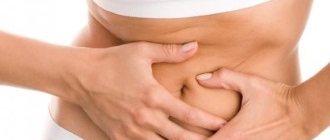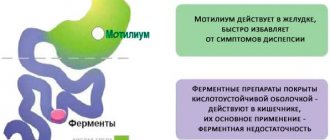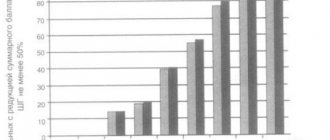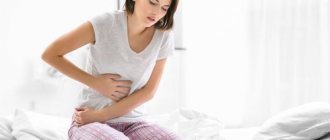What is Motilium
The active component of the drug is domperidone, a substance that can quickly suppress nausea, normalize peristalsis, stool, and relieve signs of indigestion. The product is produced in several pharmaceutical forms:
- film-coated tablets: white, biconvex, containing 10 mg of domperidone, packaged in blisters;
- non-coated sublingual tablets with mint flavor;
- syrup for children: a sweetish, thick, white, water-based liquid with a dosage of domperidone 1 mg per 1 ml, sold in glass bottles with a measuring syringe.
The tablet medicine contains auxiliary compounds: starch, povidone, stabilizers.
Forms of the produced drug
Just like adults, children also have digestive problems.
Motilium for children is produced in the form of a suspension, which has a neutral taste and is easily accepted by the child’s body without causing refusal to take it. The viscous liquid has a white tint, the main component of which is domperidone in an amount of 0.005 g. Additional components of the drug include:
- Microcrystalline cellulose
- Sodium saccharin
- Sorbitol
- Carboxymethylcellulose
- Parahydroxybenzoate
- Sodium hydroxide
- Polysorbate
- Distilled water
In addition, the drug is produced in the form of self-absorbing tablets, which contain 0.01 g of the active substance domperidone, which can be placed in the oral cavity on the tongue without additional use of liquid. Inactive substances in tablet form include:
- Aspartame
- Mannitol
- Gelatin
- Flavoring flavor
Motilium is used depending on the age category of the child, as well as individual preferences, providing the best internal effect on the body.
For what diseases is Motilium needed?
The medicine helps restore well-being in the following pathologies:
- stomach ulcer;
- atonic bowel dysfunction;
- flatulence;
- hypokinetic dyskinesia of the gallbladder;
- epigastric pain;
- nausea, vomiting due to food or chemical intoxication;
- digestive disorders due to taking medications, radiation therapy;
- spontaneous constipation;
- frequent regurgitation in children.
The drug moderately stimulates intestinal peristalsis, normalizing gastric functions and eliminating signs of dyspepsia. Domperidone suppresses dopamine activity, producing a mild antipsychotic effect. But, unlike other drugs, it does not lead to autonomic disorders.
The medicine quickly penetrates the blood through the mucous membranes and interacts with its proteins. After administration, Motilium cleanses the stomach cavity, intestinal lumen, binds and neutralizes toxic substances. It is completely excreted from the body with intestinal contents after 12–24 hours, without accumulating in tissues.
Structure of internal reactions
After taking Motilium, in a state of an empty stomach, the following chain of reactions occurs:
- Absorption. The highest level in blood plasma, after administration on an empty stomach, is achieved after 60 minutes. Low sensitivity to the active component of the drug may be due to a reduced degree of diffusion ability of the intestinal walls and liver. An increase in activity is observed in healthy people with subsequent meals. Disturbances in the motor activity of the digestive tract limit food intake to half an hour after consuming Motilium. Reduced gastric acidity reduces the diffusion capacity of domperidone.
- Transportation. Domperidone does not regulate its own metabolic process. When taken continuously for 14 days in an amount of no more than 0.3 g, the maximum content in the blood plasma is maintained within a constant level 1.5 hours after the initially taken dosage. The connection with the protein structure of plasma is at least 92%. The total content of the active component in breast milk has a ratio 4 times lower than that of the blood plasma component.
- Diffusion. Metabolism of the main substance occurs in liver cells in the form of dealkylation and hydroxylation reactions. Excretion routes are through the urinary tract and intestines in percentages of 30 and 65%, respectively. In unchanged form, domperidone is eliminated up to 10% in feces and up to 1% in urine.
In pathological disorders of the urinary system, an increase in creatinine clearance is observed, determining a low level of the active component in the blood plasma.
How to take Motilium tablets
Adults are recommended to take 1 pill three times a day, 15–20 minutes before meals. The coated tablets are washed down with cool or warm water. Sublingual - placed under the tongue until completely dissolved. If necessary, the single dose is increased 2–3 times. The maximum number of tablets per day is 8 pcs. It is allowed to take the medicine before bedtime.
For children, treatment with Motilium in tablets is recommended from 6–7 years of age: 1 tablet 2–3 times a day. For body weights less than 35 kg, it is recommended to use a suspension of the drug.
Reception technique
For early childhood, it is recommended to take the suspension form of the drug. The age category over 5 years allows taking self-absorbing tablets by immersing them in the oral cavity on the surface of the tongue. In this case, the tablet completely dissolves in a short period of time and is swallowed without requiring additional volume of water.
When using self-absorbing tablets, you should take into account the subtleties of packaging the drug form in a blister and the fragility of the structure, which can lead to breakage when opening the package. To do this you need:
- Hold the blister by the edge and remove the surface coating from the foil.
- Press down on the convex part of the package and carefully remove the tablet.
Features of taking the suspension include the following necessary technical rules for the use of packaging material and the solution itself, which must be shaken before use due to the uneven distribution of layers of the dosage form of the drug:
- The bottle cap is protected from accidental falling into children's hands, so it must be pressed and turned with force in a counterclockwise direction.
- Remove the closing part of the bottle.
- When using a package of 100 ml or more, the kit includes a pipette, which must be removed from the outer shell.
- Move the upper clamp of the pipette to the marking corresponding to the weight of the child, holding the lower clamp in place while drawing the suspension inside.
- Remove the filled pipette from the bottle, holding the lower mark clamp.
- After use, rinse the pipette with water and put on the packaging case.
- Seal the bottle with a lid
Side effects of Motilium
The drug increases the synthesis of the hormone prolactin. In some cases, this can cause a short-term disruption of the menstrual cycle and provoke the development of gynemastia. Occasionally during treatment the following are possible:
- decreased appetite;
- dryness or unpleasant taste in the mouth;
- increased drowsiness;
- increased spasms in the intestines.
If any undesirable symptoms occur, you should consult your doctor.
In what cases is the drug required?
Motilium. Release form: suspension
When the following symptoms develop, the use of motilium relieves their pronounced manifestation by eliminating the immediate cause of their formation:
- Nausea and vomiting while taking dopamine agonists when diagnosing Parkinson's pathology.
- Digestive disorders caused by systemic reflux.
- The length of time food remains in the gastric cavity.
- Feelings of bloating and excessive gas.
- Belching and heartburn.
- Pain in the epigastric region.
- Dyspeptic phenomena against the background of organic, infectious or functional origin.
- Vomiting syndrome and a feeling of nausea associated with dietary restrictions, medicinal chemistry and radiation therapy.
- Physiological disorders of motility of the digestive tract in children of early age.
When is Motilium contraindicated?
It is prohibited to use the medicine:
- in case of danger of perforation of a gastric ulcer, development of internal bleeding;
- in case of intestinal obstruction;
- in case of dysfunction, neoplasms in the pituitary gland;
- prolactinoma;
- severe kidney or liver damage;
- individual intolerance to any of the components of the drug.
If you are allergic to Motilium, itching, hyperemia, rash, lacrimation, and swelling of the mucous membranes are likely to occur. In such cases, discontinuation of therapy and replacement of the drug with another is required.
Motilium for kids
Release form, composition and packaging
The suspension for oral administration is homogeneous, white. 5 ml domperidone 5 mg. Excipients: sodium saccharin, microcrystalline cellulose, sodium carboxymethylcellulose, sorbitol, methyl parahydroxybenzoate, propyl parahydroxybenzoate, sodium hydroxide, polysorbate, purified water.
Clinical and pharmacological group: Centrally acting antiemetic drug that blocks dopamine receptors.
pharmachologic effect
Antiemetic drug, stimulant of gastrointestinal motility. Domperidone is a dopamine antagonist that, similar to metoclopramide and some antipsychotics, has antiemetic properties. However, unlike these drugs, domperidone penetrates the BBB poorly. Domperidone is rarely associated with extrapyramidal side effects, especially in adults, but domperidone stimulates the release of prolactin from the pituitary gland.
The antiemetic effect may be due to a combination of peripheral (gastrokinetic) action and antagonism of dopamine receptors in the chemoreceptor trigger zone. When taken orally, domperidone increases the duration of antral and duodenal contractions, accelerates gastric emptying - the release of liquid and semi-solid fractions in healthy people and solid fractions in patients when this process has been slowed down, and increases the pressure of the sphincter of the lower esophagus in healthy people. Domperidone has no effect on gastric secretion.
Pharmacokinetics
Suction
After oral administration on an empty stomach, domperidone is rapidly absorbed from the gastrointestinal tract. Cmax in blood plasma is achieved within approximately 1 hour. The low absolute bioavailability of domperidone when taken orally (approximately 15%) is due to extensive primary metabolism in the intestinal wall and liver. Although in healthy people the bioavailability of domperidone increases when taken after a meal, patients with gastrointestinal complaints should take domperidone 15-30 minutes before meals. Hypoacidity of gastric juice reduces the absorption of domperidone. When taking the drug after a meal, it takes longer to reach Cmax and the AUC increases slightly.
Distribution
When taken orally, domperidone does not accumulate or induce its own metabolism. After taking domperidone for 2 weeks at a dose of 30 mg/day, Cmax in blood plasma 90 minutes after the last dose was 21 ng/ml and was almost the same as after taking the first dose (18 ng/ml). Plasma protein binding - 91-93%. Concentrations of domperidone in breast milk of lactating women are 4 times lower than the corresponding concentrations in blood plasma.
Metabolism
Domperidone is metabolized in the liver by hydroxylation and N-dealkylation. In in vitro drug metabolism studies using diagnostic inhibitors, it was found that isoenzyme 3A4 is the main isoenzyme of the cytochrome P450 system involved in the process of N-dealkylation of domperidone, while isoenzymes CYP3A4, CYP1A2 and CYP2E1 are involved in the aromatic hydroxylation of domperidone.
Removal
Excretion in urine and feces is 31% and 66% of the dose taken, respectively. It is excreted unchanged in feces (10%) and urine (approximately 1%). T1/2 from blood plasma after taking a single dose in healthy volunteers is 7-9 hours.
Pharmacokinetics in special clinical situations
In patients with severe renal failure (serum creatinine level more than 6 mg/dL), T1/2 of domperidone increases from 7.4 hours to 20.8 hours, but plasma concentrations of the drug are lower than in healthy volunteers.
Indications
- a complex of dyspeptic symptoms, often associated with delayed gastric emptying, gastroesophageal reflux, esophagitis (a feeling of fullness in the epigastrium, a feeling of bloating, pain in the upper abdomen, belching, flatulence, nausea, vomiting, heartburn and regurgitation);
- nausea and vomiting of functional, organic, infectious origin caused by radiotherapy, drug therapy or diet disorders;
- nausea and vomiting caused by dopamine agonists when used in Parkinson's disease (such as L-dopa and bromocriptine);
- regurgitation syndrome, cyclic vomiting, gastroesophageal reflux and other gastric motility disorders in children.
Dosage regimen
Film-coated tablets are indicated for adults and children weighing more than 35 kg. Lozenges are indicated for adults and children over 5 years of age. In pediatric practice (especially children under 5 years of age), it is recommended to use Motilium in the form of a suspension.
For chronic dyspepsia, adults and children are prescribed 10 mg 3 times a day 15-30 minutes before meals and, if necessary, before bedtime. The maximum daily dose is 80 mg.
If necessary, for adults and children over 12 years of age, the dose can be doubled.
For children , the drug in the form of a suspension is prescribed at the rate of 2.5 ml/10 kg of body weight (which corresponds to 250 mcg/kg of body weight) 3 times a day before meals and, if necessary, before bedtime. If necessary, the indicated dose can be doubled (except for children under 1 year of age). The maximum daily dose is 2.4 mg/kg body weight, but not more than 80 mg. For nausea and vomiting, adults and children over 12 years of age are prescribed 20 mg 3-4 times a day before meals and at bedtime. The maximum daily dose is 80 mg.
Children aged 5 to 12 years are prescribed 10 mg 3-4 times a day before meals and at bedtime. The drug in the form of a suspension is prescribed at the rate of 5 ml/10 kg of body weight (which corresponds to 500 mcg/kg of body weight) 3-4 times a day before meals and before bedtime. This dose is achieved by filling the pipette twice. The maximum daily dose is 2.4 mg/kg body weight, but not more than 80 mg.
In case of renal failure, it is recommended to increase the interval between taking the drug. Because Since a very small percentage of the drug is excreted unchanged by the kidneys, there is hardly any need to adjust a single dose in patients with renal failure. However, when re-prescribed, the frequency of administration should be reduced to 1-2 times a day, depending on the severity of renal failure, and a dose reduction may also be required.
Rules for using the suspension
The bottle of suspension should be shaken before use. The suspension is supplied in child-resistant packaging, so the bottle should be opened as follows:
- Press down on the plastic cap of the bottle while turning it counterclockwise.
- Remove the unscrewed cap.
- Remove the pipette from the case (supplied only with the 100 ml bottle).
- Holding the lower ring in place, raise the upper one to the mark corresponding to the child’s weight (in kg).
- Holding the lower ring, remove the filled pipette from the bottle.
- After use, rinse the pipette with water, place the empty pipette back in the case and close the bottle.
Rules for the use of lozenges
Lozenges are available in blister packs. Since the tablets are quite fragile, they should not be pressed through the foil to avoid damage. In order to remove a tablet from the blister, take the foil by the edge and completely remove it from the cell in which the tablet is located. Then gently press down from below and remove the tablet from the package. The tablet should be placed on the tongue. Within a few seconds it will disintegrate on the surface of the tongue and can be swallowed with saliva without washing it down with water.
Side effect
- From the digestive system: rarely – gastrointestinal disorders; in isolated cases - transient intestinal spasms.
- From the central nervous system: extrapyramidal symptoms (very rarely - in children; in isolated cases - in adults); completely reversible and disappear after cessation of treatment. If the BBB is insufficiently developed (for example, in children under 1 year of age) or its functions are impaired, the possibility of neurological side effects cannot be completely excluded.
- From the endocrine system: hyperprolactinemia is possible, rarely leading to galactorrhea, gynecomastia, amenorrhea. Allergic reactions: rarely - rash, urticaria.
Contraindications
- gastrointestinal bleeding;
- mechanical obstruction or perforation, in which stimulation of the motor function of the stomach can be dangerous;
- prolactin-secreting tumor of the pituitary gland (prolactinoma);
- simultaneous use of oral forms of ketoconazole;
- hypersensitivity to the components of the drug.
Pregnancy and lactation
There is insufficient data on the use of Motilium during pregnancy. To date, there is no evidence of an increased risk of developmental defects in humans. However, the use of Motilium during pregnancy (especially in the first trimester) is possible only in cases where the expected benefit of therapy for the mother outweighs the potential risk for the fetus.
In women, the concentration of domperidone in breast milk is 10-50% of the corresponding concentration in plasma and does not exceed 10 ng/ml. The total amount of domperidone excreted into breast milk is less than 7 mcg/day when using the maximum permissible doses. It is unknown whether this level has a negative effect on newborns. Therefore, if it is necessary to use Motilium during lactation, breastfeeding should be stopped.
Use for liver dysfunction
Motilium should be prescribed with caution to patients with liver failure, given the high degree of metabolism of domperidone in the liver.
Use for renal impairment
How does Motilium interact with other drugs?
During the period of using Motilium, it is advisable to stop using antacids and proton pump inhibitors - drugs that reduce the acidity of gastric juice. Simultaneous use slows down the action of Motilium and reduces its absorption.
Antimycotic drugs and drugs from the macrolide group inhibit the metabolism of domperidone. This is important to consider in cases of impaired renal and liver function.
When undergoing treatment with Ketoconazole, Azithromycin, Erythromycin and inhibitors of the CYP3A4 isoenzyme, Motilium should be discontinued. Otherwise, the risk of heart failure increases.
Actions in case of overdose
Exceeding the permissible dose of the drug may contribute to the development of the following symptoms:
- Loss of orientation
- Drowsiness
- Extrapyramidal reactions
If these signs appear while taking the drug, you should immediately stop using the subsequent dose; activated charcoal and observation by your doctor are recommended. The development of extrapyramidal reactions requires additional treatment with antihistamines and anticholinergics.
How can I replace Motilium?
The most famous analogues and generics of the drug:
- Domrid;
- Domidon;
- Domperidone Hexal;
- Motinorm;
- Motoricum;
- Motilak;
- Peridonium.
You should not change the medicine to an alternative one on your own. In addition to differences in dosage, some of them have a wider list of contraindications; not all are approved for use in pediatrics.




